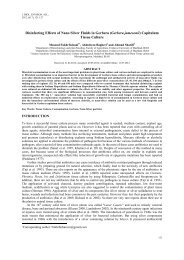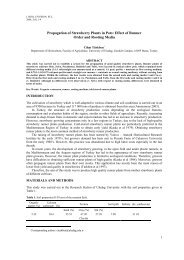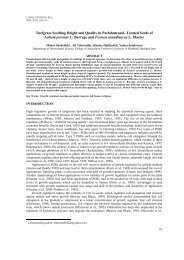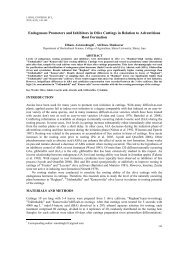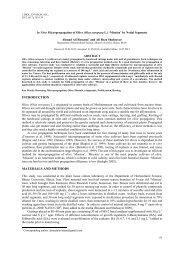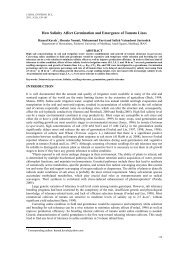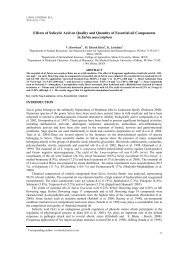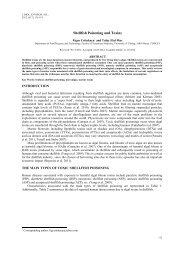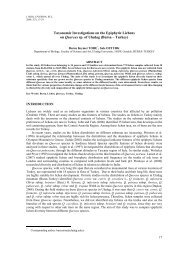The Potential of Corn (Zea mays) for Phytoremediation of Soil ...
The Potential of Corn (Zea mays) for Phytoremediation of Soil ...
The Potential of Corn (Zea mays) for Phytoremediation of Soil ...
Create successful ePaper yourself
Turn your PDF publications into a flip-book with our unique Google optimized e-Paper software.
J. BIOL. ENVIRON. SCI.,<br />
2011, 5(13), 17-22<br />
Henry JR (2000). An Overview <strong>of</strong> the <strong>Phytoremediation</strong> <strong>of</strong> Lead and Mercury. U.S. Environmental Protection Agency<br />
Office <strong>of</strong> Solid Waste and Emergency Response Technology Innovation <strong>of</strong>fice Washington, D.C.<br />
January MC (2006). Hydroponic <strong>Phytoremediation</strong> <strong>of</strong> Cd (III), Cr (III), Ni (II), As (V), and Fe (II) by HELIANTHUS<br />
ANNUUS. M.Sc. <strong>The</strong>sis, <strong>The</strong> Graduate Faculty <strong>of</strong> <strong>The</strong> University <strong>of</strong> Akron.<br />
Khodaverdi H, and Homai M (2008). investigated modeling <strong>of</strong> phytoremediation <strong>of</strong> soil contaminated with Cadmium and<br />
Lead. Science and Technology <strong>of</strong> Agriculture and Natural Resources. 42: 417-426 (in Persian).<br />
McGrath SP, Zhao J, and Lombi E (2002). <strong>Phytoremediation</strong> <strong>of</strong> metals, metalloids, and radionuclides. Advances in<br />
Agronomy, 75: 1-56.<br />
Makoi J, and Verplancke H (2010). Effect <strong>of</strong> gypsum placement on the physical chemical properties <strong>of</strong> a saline sandy<br />
loam soil. Australian Journal <strong>of</strong> Crop Science. 4(7): 556-563.<br />
Mangkoedihardjo S, and Surahmaida A (2008). Jatropha curcas L. <strong>for</strong> <strong>Phytoremediation</strong> <strong>of</strong> Lead and Cadmium Polluted<br />
<strong>Soil</strong>. World Applied Sciences Journal. 4 (4): 519-522.<br />
Parsadoost F, Bahreini Nejad B, Safari Sanjani AK, Kaboli MM (2008). <strong>Phytoremediation</strong> <strong>of</strong> lead with native rangeland<br />
plants in Irankoh polluted soils. Pajouhesh & Sazandegi. 75: 54-63 (in Persian).<br />
Rahimi B, Nejatkhah M P (2010). Availability, Accumulation and Elimination <strong>of</strong> Cadmium by Artemia urmiana in<br />
Different Salinities. J. BIOL. ENVIRON. SCI. 4(12):149-157.<br />
Shelmerdine A, Black C, McGrath S, and Young S (2009). Modelling phytoremediation by the hyperaccumulating fern,<br />
Pteris vittata, <strong>of</strong> soils historically contaminated with arsenic. Environmental Pollution. 157: 1589-1596.<br />
Sinhal VK, Srivastava A, and Singh VP (2010). EDTA and citric acid mediated phytoextraction <strong>of</strong> Zn, Cu, Pb and Cd<br />
through marigold (Tagetes erecta). Journal <strong>of</strong> Environmental Biology. 31: 255-259.<br />
Succuro JS (2010). <strong>The</strong> Effectiveness <strong>of</strong> Using Typha latifolia (Broadleaf Cattail) <strong>for</strong> <strong>Phytoremediation</strong> <strong>of</strong> Increased<br />
Levels <strong>of</strong> Lead-Contamination in <strong>Soil</strong>. M.Sc. <strong>The</strong>sis, <strong>The</strong> Graduate Faculty <strong>of</strong> <strong>The</strong> University <strong>of</strong> Akron.<br />
Visoottiviseth P, Francesconi K, and Sridokchan W (2002). <strong>The</strong> potential <strong>of</strong> Thai indigenous plant species <strong>for</strong> the<br />
phytoremediation <strong>of</strong> arsenic contaminated land. Environmental Pollution. 118: 453-461.<br />
Xiao X, Tongbin C, Zhizhuang A, and Mei L (2008). <strong>Potential</strong> <strong>of</strong> Pteris vittata L. <strong>for</strong> phytoremediation <strong>of</strong> sites cocontaminated<br />
with cadmium and arsenic: <strong>The</strong> tolerance and accumulation. Journal <strong>of</strong> Environmental Sciences. 20:<br />
62-67.<br />
Zhang H, Dang Z, Zheng LC, and Yi XY (2009). Remediation <strong>of</strong> soil co-contaminated with pyrene and cadmium by<br />
growing maize (<strong>Zea</strong> <strong>mays</strong> L.). Int. J. Environ. Sci. Tech. 6 (2): 249-258.<br />
22



